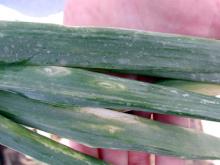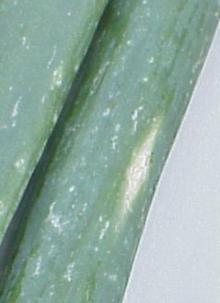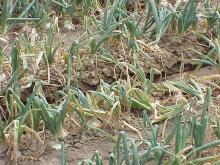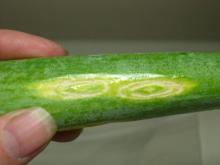By D. H. Gent and C. M. Ocamb
Cause Iris yellow spot virus (IYSV) was first spotted on onion seed crops in the Treasure Valley in the Pacific Northwest around 1989. Overwintering onions fields were affected during the early years of the epidemic but by 2001, disease appeared in bulb crops across the Pacific Northwest. It has been reported on onions in across the United States and many other countries. This virus is known to infect members of the Allium group: onion, garlic, leek, chive, shallot, Oriental garlic (A. tuberosum), Welsh onion (A. fistulosum), and Allium vavilovii (a wild plant closely related to onion). A number of weeds and ornamentals may also be infected by IYSV, including: prairie gentian/lisianthus (Eustoma russellianum, E. grandiflorum), Dutch iris (Iris hollandica), Alstroemeria sp., amaryllis (Hippeastrum hybridum), Cycas sp., geranium (Pelargonium hortorum), Rosa spp., Scindapsus sp., and common purslane (Portulaca oleracea). Examination of weeds in Treasure Valley detected IYSV-infected redroot pigweed (Amaranthus retroflexus), puncturevine (Tribulus terrestris), kochia (Kochia scoparia), prickly lettuce (Lactuca serriola) and lambsquarters (Chenopodium album). In Georgia, twenty different weed species were positive for IYSV via serological testing, but only spiny sowthistle (Sonchus asper) infections were confirmed with RT-PCR. Tomato spotted wilt virus, a thrips-transmitted virus closely related to IYSV, has been reported on onion in Georgia, but disease symptoms appear very similar or identical to iris yellow spot.
This virus is transmitted by onion thrips (Thrips tabaci) but has not been shown to be transmitted by other thrips species such as the western flower thrips (Frankliniella occidentalis) or yellow flower thrips (F. schultizei). However, tobacco thrips (Frankliniella fusca) were recently shown to transmit the virus too. Transplants can be infected with IYSV as well as carry high populations of onion thrips. Studies have not shown this virus to be transmitted by onion seed.
Symptoms Affected onion seed crop plants have yellowish or tan diamond-shaped lesions on flower stalks. Some lesions have concentric rings; alternating green and yellow or tan. Infected flower stalks develop necrosis, die, and fall over. In onion bulb crops, diamond-shaped lesions may be rarely observed. Instead, necrotic areas develop on leaves, and can be elongated brown lesions or brown flecks that resemble thrips injury. Dried, elongated lesions that are characteristic in bulb crops, can be found on the youngest leaves. Severe pink root or other root rot can resemble the foliar problem but IYSV will not rot the bulb plate or roots. Elongated brown lesions can be colonized by saprophytic fungal and resemble purple blotch. Bulb size can be decreased, resulting in fewer colossal and jumbo grade bulbs. Affected fields may have diseased plants in clusters but sometimes nearly the entire field may be diseased, but the highest incidence of disease is often found near field edges. More severe disease may be observed in fields under stress.
Cultural control
- Promote a healthy vigorous crop and avoid stress. Practice good fertility and water management.
- Select varieties that are less susceptible to iris yellow spot. White varieties tend to be most resistant, and red varieties most susceptible.
- Control volunteer and wild alliums.
- Destroy onion cull piles.
- Planting onion varieties that are less susceptible to thrips will not prevent disease but may slow spread in a field. However, there are no varieties that are resistant to thrips.
- Plant as densely and uniformly as possible.
- Overhead irrigation can provide some suppression of thrips and iris yellow spot.
- Thrips migrate from drying wheat and bean fields to nearby onion fields. Field sites that are protected from these thrips sources may reduce virus transmission.
- Plant virus-tested (and found to be free of viruses) transplants. Onion seeds will not carry IYSV.
- Reduce or eliminate overwintering onions.
- Isolate overwintering bulb and seed fields from other onion crops.
- Eliminate weeds in and around onion fields.
Chemical control Monitor the population of onion thrips and control thrips with labeled insecticides. Consult the PNW Insect Management Handbook for currently effective materials.
- Actigard 50WG (Group P1) at 0.5 to 1 oz/A beginning at 4 to 6 weeks before bulb initiation and continue on a 7- to 10-day interval for suppression of IYSV. Do not apply within 7 days of harvest. 12-hr reentry.
References Gent, D.H., du Toit, L.J., Fichtner, S.F., Mohan, S.K., Pappu, H.R., and Schwartz, H.F. 2006. Iris yellow spot virus: An Emerging Threat to Onion Bulb and Seed Production. Plant Disease 90:1468-1480.
Srinivasan, R., Sundaraj, S, Pappu, H.R., Diffie, S., Riley, D.G., and Gitaitis, R.D. 2012. Transmission of Iris yellow spot virus by Frankliniella fusca and Thrips tabaci (Thysanoptera: Thripidae). J Econ Entomol 105(1):40-47.





